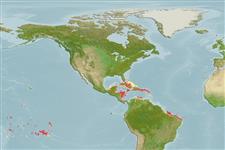>
Kurtiformes (Nurseryfishes, cardinalfishes.) >
Apogonidae (Cardinalfishes) > Apogoninae
Etymology: Apogon: Greek, a = without + Greek pogon = chin, beard (Ref. 45335); robbyi: Named after Dr. C. Richard ('Robby') Robins..
Environment: milieu / climate zone / depth range / distribution range
पारिस्थितिकी
समुद्री ड़िमरसल; गहराई सीमा 1 - 30 m (Ref. 26883). Tropical
Western Central Atlantic: Belize, Nicaragua and Jamaica.
आकार / वज़न / Age
Maturity: Lm ? range ? - ? cm
Max length : 3.6 cm SL पुल्लिंग / अलिंग; (Ref. 26883)
Found in a wide variety of habitats, including grass flats, partially open sand bottoms around the bases of finger and globose sponges, tentacles of anemones, inside live conch shells, and around coral reefs and high relief structures such as artificial reefs (Ref. 26883). Presumably, striped cardinalfish leaves its daytime hovering places to forage over grass and sand flats at night (Ref. 26883).
Life cycle and mating behavior
परिपक्व अवधि | पुनरुत्पत्ति | मछलीऔ का अंडे देना | अंडे | Fecundity | लार्वा
Mouthbrooders (Ref. 240). Distinct pairing during courtship and spawning (Ref. 205).
Gilbert, C.R. and J.C. Tyler, 1997. Apogon robbyi, a new cardinalfish (Perciformes: Apogonidae) from the Caribbean Sea. Bull. Mar. Sci. 60(3):764-781. (Ref. 26883)
IUCN Red List Status (Ref. 130435)
Threat to humans
Harmless
Human uses
मात्स्यिकी: कोई रुचि बग़ैर
अधिक जानकारी
Age/Sizeबाढ़Length-weightLength-lengthLength-frequenciesमौरफोमैटरिक्सआकृति विज्ञानलार्वालारवल गतिकीभर्तीबहुतायतBRUVS
संदर्भजलीयकृषिजलीयकृषि रूपरेखाखींचआनुवंशिकीElectrophoresesहैरेटिबिलटीबीमारीप्रक्रमणNutrientsMass conversion
सहयोगीयोतस्वीरेStamps, Coins Misc.ध्वनिसिगुयटिरारफ्तारतैरने के प्रकारगिल क्षेत्रOtolithsदिमागदृष्टि
साधन
Special reports
Download XML
इंटरनेट स्रोत
Estimates based on models
Preferred temperature (Ref.
123201): 27.2 - 28.2, mean 27.8 °C (based on 338 cells).
Phylogenetic diversity index (Ref.
82804): PD
50 = 0.5000 [Uniqueness, from 0.5 = low to 2.0 = high].
Bayesian length-weight: a=0.01479 (0.00690 - 0.03171), b=3.09 (2.91 - 3.27), in cm total length, based on LWR estimates for this (Sub)family-body shape (Ref.
93245).
Trophic level (Ref.
69278): 3.3 ±0.4 se; based on size and trophs of closest relatives
लौटाव (Ref.
120179): ऊंचा, न्यूनतम जनसंख्या दुगनी समय अवलागत 15 महीने। (Preliminary K or Fecundity.).
Fishing Vulnerability (Ref.
59153): Low vulnerability (10 of 100).
